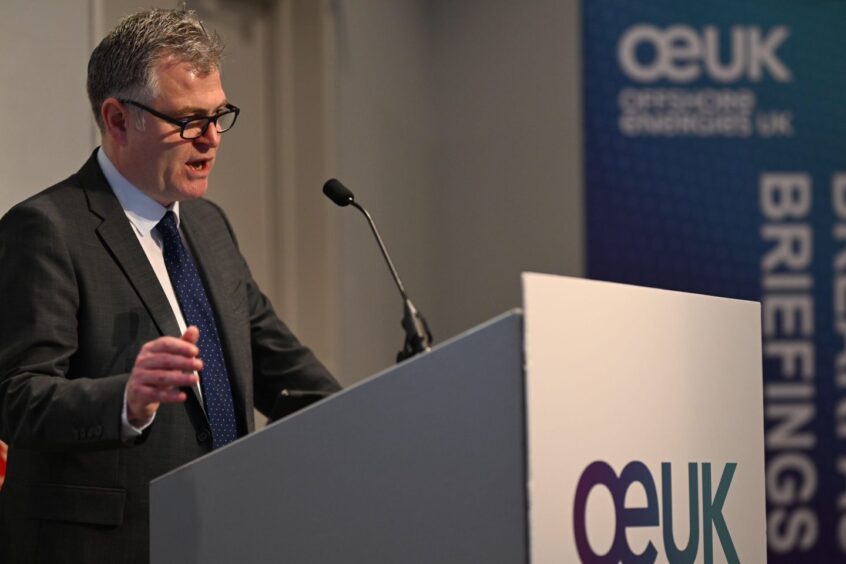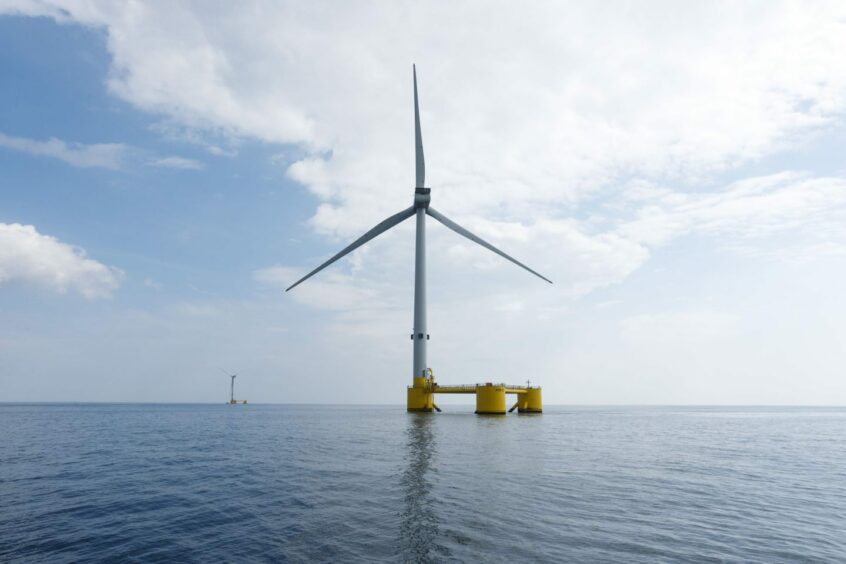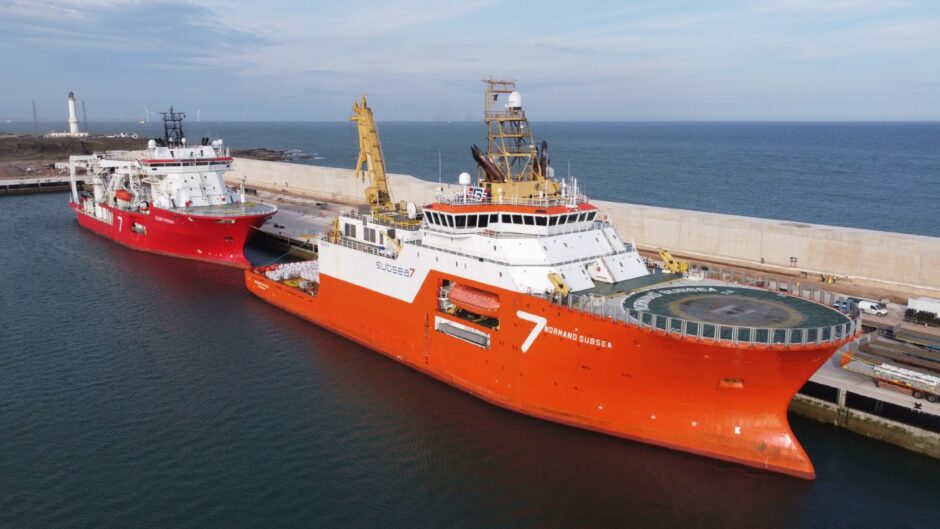
The energy transition to net zero will be the “biggest engineering project this country has ever seen”, the boss of the UK’s offshore energy trade body said.
Offshore Energies UK (OEUK) chief executive David Whitehouse was speaking as he introduced a breakfast event ahead of the opening of the All Energy show in Glasgow.
The panel session launched the group’s latest report outlining the challenges of delivering the UK’s ambitions for offshore wind.
Insight findings
The UK is currently the second largest global market in the offshore wind sector with 15GW installed, plus the same again for onshore wind.
The report warns that while ambitions grow, confidence in the UK’s ability to deliver “remains uncertain”.
Speaking at the event, Thibault Cheret, OEUK wind and renewables manager, warned the UK is currently not on track to meet its target 2030 for 50GW, including 5GW floating.
Challenges include cost inflation, prolonged consenting timelines and supply chain pressure as well as the current UK funding model, known as contracts for difference (CfD), which the report describes as a “race to the bottom” as the UK government seeks to push down the cost of delivering renewable energy projects.
Meeting targets will be “unlikely” without “substantial investment”. Currently investment in offshore wind is around £7.7bn per year but should double to £15bn by 2032 and reach £29bn by 2035, the OEUK report said.
Marie Lucy, renewable energy M&A partner for Deloitte, said 2032 was a “particularly difficult year for the offshore wind wind industry and 2024 will be critical”.
“We will see if we can reverse this trend in costs … and whether or not will we hit targets by the end of the decade,” she said.
“Race to the bottom”
The report highlighted how the decline in pricing through the UK government’s auction funding model as affected the sector.
The failure of CfD5 to meet costs prevented any offshore wind developers from bidding and some CfD4 wind farms are facing a “struggle”.
“We do need prices to increase,” said Steven Wilson, director of capital projects – offshore, SSE Renewables, who joined a panel of speakers.
“Will floating wind be competitive? Absolutely,” he added.
Government has boosted the budget for AR6, but OEUK said this “may be too weak to support construction of the capacity that the 2030 target needs”.
It said industry should increasingly look to power purchase agreements (PPAs) directly with energy users.
Picking up the pace
The pace of wind development is too slow. The report estimates at current development times, the UK will only reach 40GW offshore wind including and 2GW floating by 2033. Consents need double in speed and there will have to be “significant advances in grid capacity”.
It added that the delay to National Grid ESO’s delayed holistic network design (HND) setting out connection to the grid does “not augur well” for 2030 targets.
OEUK noted that the National Grid’s estimate it will need to spend £54bn in upgrade is the “equivalent to squeezing the last 30 years’ investments into six years: a challenge for both manpower and finance”.
It added that proposals to implement “zonal pricing”, matching areas of demand and supply, could “potentially jeopardise” ScotWind projects which are away from centres of energy use.
INTOG stepping stone
OEUK says the 5.5GW on track for 2030 for INTOG projects is “critical” if the UK is going to achieve its gigawatt goals.
This is mainly because it will be a “stepping stone” for floating wind technology, which has “four times more potential” than fixed wind. OEUK notes “most of the world’s capacity composed of demonstrators”.
Claire Tindle, the energy offtake manager for Flotation Energy was also on the panel. Flotation is developing Green Volt, considered to be the front runner INTOG project.
She said there were financial challenges but added “we are creating a new industry”.
“We are confident with the backing of our investors we will be able to secure the finance needed.”
Meanwhile OEUK believes the floating wind sector could be a “game changer” for the UK. However, currently the technology has a “high price tag”, Cheret said.
Supporting the supply chain
The report underlines the UK’s existing strengths including expertise in deep marine operations and subsea systems engineering, electrical systems and cables.
OEK said the energy supply chain is “much better positioned to capture a sizeable market share” in floating wind than has been the case with fixed.
To date, there has been dismay amongst some areas of the the supply chain over small slices of the offshore pie offered to “local content” in current wind projects.
Liam McIntyre, strategy director, UK and global IRM region, Subsea7 highlighted some of the challenges facing the supply chain companies.
He said Subsea7 has been working in offshore wind for 15 years but the last ten years have been a “real struggle” to secure profits.
“Some of our peers have left the sector in that time,” he said.
But he says the firm is “cautiously optimistic”.
“There is a need for greater installation capacity to meet any of these targets.
“The challenge is you’ve got supply chain like ourselves who are nervous about investing in that.
“It is a huge risk for someone like us to invest in tonnage to build these fixed and floating wind farms when we just don’t know the timing of it.”
The report identified areas that will require focus support and investment including engineering, fabrication and construction of offshore foundations, using UK ports.
Other areas should look to expand manufacturing of equipment such as moorings and anchors and cables while focus is also needed on anchor-handling and offshore construction vessels.
OEUK estimates there will be a further £132bn spent to reach 65GW by 2035.
OEUK added: “The existing UK expertise in subsea engineering and technology, deep water operations, including health, safety and environment, and floating structures should help position the UK as a leader in the floating wind market.”
The trade body based its outlook on 400 member companies. It said it was in its second year of having expanded its remit to firms working in energy sectors beyond oil and gas.
Its members working in renewables and low-carbon technology reflect the “evolving interests and increasing diversification” of the oil and gas supply chain operators”, it said.
Offshore wind at ‘inflection point’
Lucy said the challenge facing offshore wind was one that needed to be tackled.
“People think offshore wind is easy to build, execute and develop but it isn’t.”
The former Orsted executive said she had seen “horror stories” during construction. It had been easier to address these challenges when “margins were much healthier” than now. “People could absorb those issues in delays and cost overruns.”
She added: “We are at an inflection point in the industry where continued downward pressure on prices is not matching the desire for gigawatts and the targets that are being set for the end of the decade.”
Recommended for you


 © Supplied by Flotation Energy
© Supplied by Flotation Energy © Supplied by Port of Aberdeen
© Supplied by Port of Aberdeen